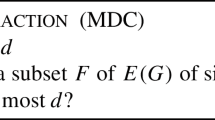Abstract
In this paper, we introduce the Maximum Matrix Contraction problem, where we aim to contract as much as possible a binary matrix in order to maximize its density. We study the complexity and the polynomial approximability of the problem. Especially, we prove this problem to be NP-Complete and that every algorithm solving this problem is at most a \(2\sqrt{n}\)-approximation algorithm where n is the number of ones in the matrix. We then focus on efficient algorithms to solve the problem: an integer linear program and three heuristics.
Access this chapter
Tax calculation will be finalised at checkout
Purchases are for personal use only
Similar content being viewed by others
Notes
- 1.
The meaning of \([\![p; q ]\!]\) is the list \([p,p+1,\dots , q]\).
- 2.
The implementations can be found at https://github.com/mouton5000/MMCCode.
References
Pillai, A., Chick, J., Johanning, L., Khorasanchi, M., de Laleu, V.: Offshore wind farm electrical cable layout optimization. Eng. Optim. 47(12), 1689–1708 (2015)
Karp, R.M.: Reducibility among combinatorial problems. In: Miller, R.E., Thatcher, J.W., Bohlinger, J.D. (eds.) Complexity of Computer Computations, pp. 85–103. Springer, Heidelberg (1972)
Håstad, J.: Clique is hard to approximate within n\({\hat{}} (1-\epsilon \)). Acta Math. 182(1), 105–142 (1999)
Watel, D., Poirion, P.: The Maximum Matrix Contraction problem: Appendix. Technical report CEDRIC-16-3645, CEDRIC laboratory, CNAM, France (2016)
Lubin, M., Dunning, I.: Computing in operations research using Julia. INFORMS J. Comput. 27(2), 238–248 (2015)
Author information
Authors and Affiliations
Corresponding author
Editor information
Editors and Affiliations
Rights and permissions
Copyright information
© 2016 Springer International Publishing Switzerland
About this paper
Cite this paper
Watel, D., Poirion, PL. (2016). The Maximum Matrix Contraction Problem. In: Cerulli, R., Fujishige, S., Mahjoub, A. (eds) Combinatorial Optimization. ISCO 2016. Lecture Notes in Computer Science(), vol 9849. Springer, Cham. https://doi.org/10.1007/978-3-319-45587-7_37
Download citation
DOI: https://doi.org/10.1007/978-3-319-45587-7_37
Published:
Publisher Name: Springer, Cham
Print ISBN: 978-3-319-45586-0
Online ISBN: 978-3-319-45587-7
eBook Packages: Computer ScienceComputer Science (R0)




